- March 27, 2023
- Posted by: Muhammad Shoaib Afzal
- Category: VI. Sales Module

SALES MODULE
Vaival ERP system offers a Sale Module that starts from Quotation, Sale Order, Outward Gate Pass of Sale Order, Sale Invoice, till Outward Gate pass of Sale Invoice. Documents are generated in each step to assist the user in managing and keeping up with evidence of transactions. This module is integrated with financial statements. All the data entered in these modules automatically reflect in the reporting module and also in the dashboard.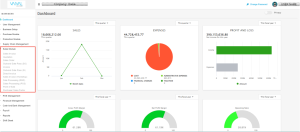
Out of the whole module, the below figure shows the traditional sale cycle, other screens of this module are used for direct sales, where no proper cycle is followed, to give the user flexibility for maintaining their books.
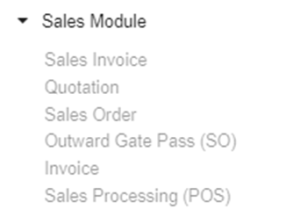
SALES INVOICE:
From this screen, you can book your sales. This is a simple sale invoice that you can use separately or with the sale cycle. To enter a sale invoice, you have to enter the details in the filters given in the below figure. And after adding the necessary details you will click on the “SAVE AS DRAFT” button on the bottom of the screen and this will automatically go to a draft listing from where the person who has the right to approve will approve this invoice and then this will be reflected in the financial statements.
Figure: Sales Module > Sale Invoice
SALES CYCLE:
Quotation
In the Sale module if you want to follow the sale cycle, first you have to start with a quotation, which is an optional step. For adding quotations, you have to enter the details asked in the fields appearing in the figure below, after adding the necessary details you will save the quotation. As Quotation is just a potential figure thus it has no financial impact, you can also skip that, it’s completely your own choice to add this or not to add this, the sale cycle would work the same with this or without this.
Figure: Sales Module > Quotation

Sale Order (S.O)
The second step in our sale cycle is adding a sale order. After quotation (Optional) you will add a sale order or directly add a sale order, same pattern is repeated here add the necessary details in the sale order screen and save it. After saving you can find your added Sale order in the draft listing from where an approving authority would approve the added sale order and then these will move to approve the listing.
Figure: Sales Module > Sale Order (S.O)
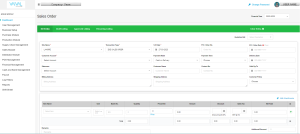
Our system also provides a recurring listing, which means that if you have a sale order which is repetitive daily, monthly, quarterly, bi-yearly, or yearly you can add this once and ask the system to repeat and add it automatically on the required dates. To use this feature, you have to click on the small arrow given on the right side of the option “Save as draft”. Upon clicking this you will see a drop-down where you have to click on “Save as Recursion”. As you can see in the figure below.
Figure: Sales Module > Sale Order (S.O) > Recursion Listing 1

The entries that you saved as recursion will appear on the Recursion listing screen, form here you can enter the time interval that you want of the order you wish to repeat or you can use them right away from the options highlighted in the below figure.
Figure: Sales Module > Sale Order (S.O) > Recursion Listing 2
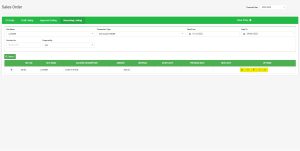
In order to add a recurring interval to your sale order, you have to click on the icon highlighted below figure, as you click on this icon a window will pop up as you can see in figure 4 of the recursion listing, select the frequency of the recurring order from the available options, such as weekly, monthly, quarterly, or annually. Once you have saved the recurring order settings, the system will automatically create a new order at the specified frequency and quantity, based on the start and end dates that you have chosen. You also have the option to edit or cancel the recurring order at any time.
Figure: Sales Module > Sale Order (S.O) > Recursion Listing 3

Figure: Sales Module > Sale Order (S.O) > Recursion Listing 4

Outward Gate Pass (S.O)
After entering a Sale order, the next step of the sale cycle is to enter an Outward gate pass. This means that the quantity which was ordered is being dispatched. you are able to select the sale order directly from a list of open orders by using “S.O Reference” as where your sale orders will appear. Enter the details of the gate outward pass, such as the date and time of the shipment, the quantity and type of products being shipped, and the name of the carrier or transport company. You may also have the option to upload supporting documents from “Add Attachment”. Save the gate outward pass. This will update the inventory levels and stock status of the products in your system.
Figure: Sales Module > Outward Gate Pass (S.O)

Invoice
Once the sale order has been fulfilled and dispatched, a sale invoice needs to be made in the system based on the details of the sale order. The invoice includes details such as the customer’s name and address, order date, product description, quantity, price, and total amount due. After providing the necessary details you can save the Sale invoice.
Figure: Sales Module > Invoice
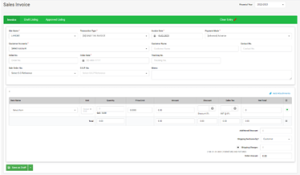
SALES PROCESSING (POS):
The Sale Processing (POS) screen allows you to process sales transactions, accept payments, and generate receipts for customers. It tracks inventory levels in real time, allowing you to manage your stock levels. Our system provides integrated POS as the data entered is automatically updated in our system you can view the daily sale of POS from this screen. Here as you process these transactions it goes to draft listing and then an approving authority approves it and this will reflect in stock and other reports.
Figure: Sales Module > Sale Processing (POS)


